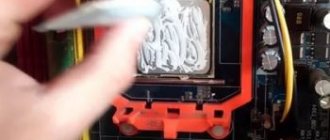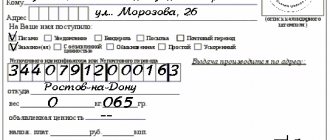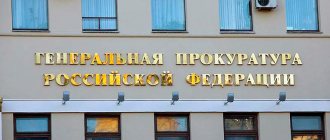GOST standards
Characteristics are regulated by the state:
Free HOTLINE:
Moscow time 8 (499) 938 6124
St. Petersburg 8 (812) 425 6761
Fed 8 (800) 350 8362
- GOST 12.4.121-2015 “System of occupational safety standards (OSSS). Personal respiratory protection. Filtering gas masks. General technical conditions" contains brands, classes, categories, and other requirements for personal protective equipment.
- GOST 12.4.166-85 “System of occupational safety standards (SSBT). Front part of ShMP for industrial gas masks. Technical conditions".
- GOST 12.4.235-2012 “SSSSBT. Personal respiratory protection. Gas and combined filters. General technical requirements. Test methods. Marking".
- GOST 8762-75 “Round thread for gas masks and calibers for it.”
What law regulates recycling?
Disposal of civil defense funds is carried out in accordance with the requirements of the laws of the Russian Federation. These laws are mandatory for all Russian citizens:
- Law “On placing orders for the supply of goods, performance of work, provision of services for state and municipal needs”;
- Law “On Production and Consumption Waste”;
- Law “On licensing activities for the collection, use, neutralization, and disposal of waste of I-IV hazard classes.”
We recommend reading: How do different countries deal with garbage?
How to find out?
IMPORTANT! Professional military gas masks are not available for free sale; permits are required to obtain them from the manufacturer. Products for industrial, civil, military, and firefighting purposes must have a batch form.
You can find out the date of manufacture by examining the product. The marking of different models has its own characteristics. For civilian versions and additional cartridges, it is applied to the bottom and side surface of the box:
- brand of filter-absorbing box GP-7k, DPG-3;
- the bottom line consists of several numbers, for example 90-4-05-167: 90 – manufacturer’s code; 4 – quarter, 05 – year of manufacture; 167 – batch number;
- The year of manufacture is also indicated on the upper surface of the filter housing - 05 (2005).
Protective masks from the Yaroslavl plant are marked as follows:
- The number in the circle is the size.
- Next F and number - form.
- I am the manufacturer's sign. Numbers, dots – year and quarter of release.
- The year of manufacture of plastic inhalation and exhalation valves is calculated by adding the number of points on the part and the year of manufacture of the mold, that is, “05..” means 2007.
An instruction manual is placed in each box of gas masks, where you can find the warranty period of storage. By adding it to the production date, it is easy to understand when PPE must be disposed of.
NPN-59L – anti-fog films – do not contain markings. Inside there is an insert with information:
- name of the plant;
- batch number;
- quantity;
- month, year of manufacture.
Purpose of civilian gas masks
The devices are used to protect people living in areas of infection and in industries contaminated with harmful substances. GP-7 gas masks can be used at home if necessary. Modifications include devices for drinking water. Panoramic glass provides excellent visibility. The devices protect the respiratory system for several hours.
Components of a civilian gas mask:
- metal box;
- front part of IHL;
- anti-fog film;
- insulating cuffs MNU-3;
- rubber cord;
- bags for gas masks;
- user manual;
- product form.
The gas mask is lightweight and has a convenient design. Some models are equipped with a DPG-3 cartridge for additional protection. This is necessary when exposed to ammonia, phosgene, chlorine, sulfur hydride and similar substances.
Table by types and terms
| Type, components | Shelf life (years) | |
| Exploitation | No operation | |
| GP-5 | 1,5 | 3-5 |
| GP-7 | 1,5 | 12 |
| GP-7VM | 1,5 | 12 |
| PDF-2D(sh) | 1,5 | 10 |
| IP-4M | 1,5 | 5 |
| IP-4M with built-in cartridge | 1 | 1 |
| IP-4MK | 1,5 | 5 |
| IP-6 | 1,5 | 5 |
| Filter box | Few hours | Similar to PPE |
| Mask | 1,5 | Similar to PPE |
| Pencil | 1,5 | Similar to PPE |
Shelf life of the gas mask filter
Regardless of the marking of the filter box, the general warranty period is 3-5 years. It is impossible to name a specific period, since it may vary for each manufacturer.
But there are several guidelines that will give a reason to replace the filter:
- There is a distinct smell of gas under the mask.
- The weight of the device has changed due to moisture absorption.
- The filter has been in use for more than 100 hours.
The expiration date of the filter can be found out when checking the gas mask itself using experimental modeling.
Storage
The service life directly depends on the conditions in which it is stored.
No operation
Without use, PPE can be stored for 10–12 years, the specific period depends on the model.
Operating period
After the start of use, with proper storage and operation, the protective equipment will last 1.5-2 years, after which it must be written off. But some components, such as a filter, need to be changed regularly as soon as a foreign smell appears.
Storage conditions
It is recommended to store PPE under the following conditions:
- The room must be equipped with ventilation and emergency lighting.
- The floor has a hard surface; you need to keep it clean and regularly remove dust and dirt.
- Humidity – up to 60%.
- The windows are glazed, equipped with sun protection, and grilles are installed.
- Periodically carry out deratization.
- Temperature range +5…+15 °С. It is important to protect products from changes of more than 5 degrees, otherwise condensation will appear.
IMPORTANT! It is unacceptable to store PPE in the same room with chemically active, acidic, flammable objects.
Maintenance
In order for PPE to function properly for the allotted period of time, it is necessary to carry out maintenance. It involves checks and inspections by potential users. The checks will be slightly different for different types.
This event consists of two components. For filters, the following steps will be required.
Visual inspection for the presence and integrity of components:
- The mask and headband must be free of cuts and punctures. To identify flaws, you need to stretch it slightly.
- Next, the spectacle assembly is examined to ensure there are no scratches or chips.
- The presence and condition of the inhalation and exhalation valves and the safety screen in the valve box are checked.
- The connection between the mask and the tube must be tight. Check the integrity of the union nut and the presence of a rubber spacer ring on the nipple.
- Rust and dents on the filter box are unacceptable.
- The bag must also be intact, have straps, clasps, a waistband, and a wooden bottom.
Equally important is checking for leaks. You need to put on a mask, close the hole at the bottom of the box with your palm, and try to inhale air. If this cannot be done, the mask is sealed. If not, the PPE is damaged and requires replacement.
The insulating type check is performed in the same way . The following are subject to inspection:
- Punctures and cuts on the helmet mask are unacceptable.
- Spectacle units without scratches, chips, cracks.
- Strong fastenings on the connecting tube.
- Regenerative cartridge without rust, dents or holes.
- Availability and serviceability of the starting briquette.
- The breathing bag has no breaks or punctures.
- The overpressure valve is OK.
- The frame is without cracks or dents, the cartridge mount is strong.
A leak test is performed after assembly, similar to a filter gas mask.
Modifications of GP-7
Now the GP-7 gas mask is obsolete. New models are more functional and convenient to use.
GP-7BT is an improved modification, manufactured according to the latest requirements of the Ministry of Emergency Situations. The device is characterized by enhanced protection and high efficiency.
Advantages of GP-7BT:
- the box is not subject to corrosion in aggressive environments;
- air does not get inside due to the plasticity of the material;
- expanded scope of application of the device;
- compactness and light weight.
GP-7BT gas masks use a carbon-based catalyst. The model can be used when located in an environment contaminated with vapors of ammonia and other substances.
GP-7BTV is a device that effectively protects against chemically hazardous substances. The audibility and intelligibility of speech is at a high level (90-100%). The model is designed in accordance with current safety requirements. The GP-7BTV gas mask consists of high-quality materials that ensure durability and reliable operation.
Kinds
The generally accepted classification is based on the type of construction and method of protection - filtering and insulating.
Filtering
They consist of a filter that protects the respiratory tract and lungs from exposure to chemicals, purifying the air. Their disadvantage is the constant need to replace filters every few hours.
Types: GP-5 or EO-62 (out of production), GP-7 (V, B, K, KB) GP-21, GP-75, UZS VK 320, UZS VK 600, PDF-2D, PDF-2Sh , PMG-2.
Insulating
Insulating ones are more versatile and better protect against exposure to chemicals. Used in conditions of lack of oxygen. Their peculiarity and advantage is that a person breathes not obtained from the external environment, but pre-prepared clean air from a special source. The disadvantage is the limited life of the air cylinder, which is usually about 3 hours.
Types: IP-4M with cartridge RP-4-01, IP-4MK with cartridge RP-7 or RB-7B, IP-6 with cartridge RP-6, PSh-1 (B, S-20, B-20, 20RV , 40РВ).
A little history
In the 1960s, the GP-5 gas mask was developed, which was used and modernized for 20 years. Over time, the device was replaced with an improved model GP-7. The design has become more convenient and safer - a reliable mask with viewing glasses, a new belt fastening system. Powerful filters provide protection against a variety of toxic substances.
The GP-7 model is produced at three factories in Russia. The devices are designed for a long service life and are perfectly combined with other protective equipment. The GP-7 gas mask is used in areas exposed to toxic gases and radioactive dust.
Accessories
Gas mask components also have their own expiration dates.
Helmet mask
The mask is made of special durable rubber, which, if the conditions are met, will be suitable for the entire shelf life of the protective equipment.
For example, the PPM-88 panoramic mask has a warranty period of 6 years, ShMP, ShMP-1 can be used for a similar period.
Absorbing box
The filter-absorbing box is a component of protective equipment. Under proper conditions, it retains its characteristics throughout the shelf life of the PPE.
Filter
The filter (for example, DOT, DP-2) is the basis of the action of filter gas masks. It is designed to purify the air from the external environment and make it suitable for inhalation. Therefore, it must be changed immediately after foreign odors appear.
Pencil
The pencil prevents the formation of condensation on the glasses of the mask. It has a soap base, so the expiration of its service life is equivalent to the product itself.
Time limits for checking gas masks
If we are talking about warehousing, then during the life of PPE it undergoes several checks:
- The first is at the end of the warranty period.
- The second – 5 years after the end of the warranty period.
- Subsequent ones - once every 2 years.
The maximum shelf life will be 15 years, after which the gas mask is disposed of completely.
The procedure for testing protective equipment has been established by the Ministry of Emergency Situations of the Russian Federation and is carried out in special laboratories. There have been no changes in this area for 2020.
Gas masks are delivered for inspection by the organizations that purchased them. After the expiration of the gas mask's service life, samples are removed from the warehouse and replaced with new models.
Parts validity
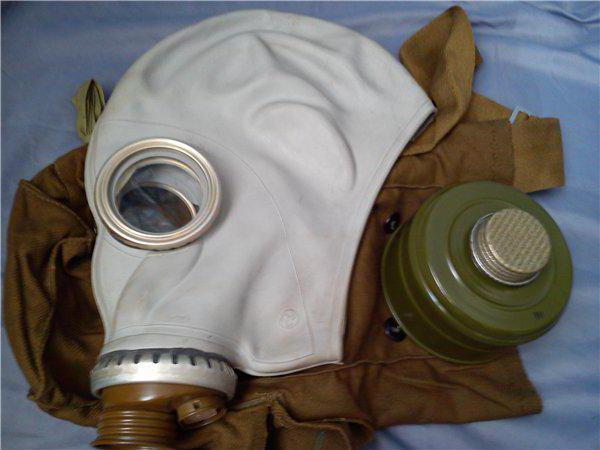
When creating gas mask elements, markings are applied to the box. It includes information about the manufacturer, equipment time. The product index is also indicated there. The marking consists of the following information:
- the first 2 digits indicate the month the device was manufactured;
- second 2 – year;
- the last 2 are the batch number.
For some parts of the device, the shelf life may be extended. Boxes come in filter and filter-absorbing types. Usually they are painted in different colors so as not to be confused when replacing. Before using a gas mask, you need to familiarize yourself with the operating instructions. This will allow you to act quickly and accurately in an emergency.
general information
The fundamental difference between this model and its predecessors is the absence of a corrugated tube to connect the filter box to the gas mask helmet.
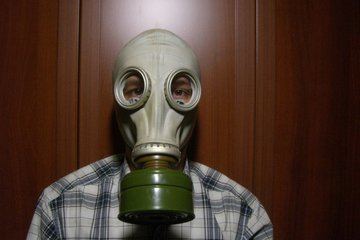
The gas mask elements connect directly to each other, but are compatible with the connecting tubes of some other models.
Simultaneously with the GP-5, a modified model of the GP-5M gas mask, compatible with membrane-type intercoms, was produced for emergency rescue units. The ShM-66MU helmet-mask was made of thin rubber ; the design included cutouts for the ears.
Disposal of self-rescuers
Self-rescuers (including SPI), which are recognized as unusable, are subject to write-off and further disposal. For this purpose, a special commission is created and an official document (act) is drawn up. It records the action that occurred. Next, the act is certified by officials authorized in this matter. The document is approved by the chief engineer of the enterprise on whose balance sheet PPE equipment is listed. The date of manufacture and numbers assigned to gas masks by the manufacturer must be recorded.
Self-rescuers are destroyed in accordance with all the rules for safe work with explosive substances. Disposal method is incineration.
Disposing of PPE in areas with public access is prohibited.
Disposal of self-rescuers is a complex multi-stage process. Recommendations and safety requirements must be followed. Only in this case will people save the planet and natural resources.
The effect of a gas mask on the body
⇐ PreviousPage 2 of 4Next ⇒
When using a gas mask, three factors act on the human body: breathing resistance, harmful space and pressure of the front part on the head. Breathing resistance is measured by the difference in air pressure in the atmosphere and in the space under the helmet-mask (mask) and is expressed in millimeters of water column. Breathing resistance depends on the filtering surface and the density of the anti-aerosol filter, on the filtration area and layer thickness, the size of active carbon grains, as well as on the speed of movement of inhaled air, which in turn is determined by the amount of air consumed per minute. Its amount depends on the nature of the physical activity. At rest, a person consumes 9 liters per minute, while standing - 12 liters, when walking at a speed of 4 km/h - 25, when running at a speed of 12 km/h - 64 liters. Accordingly, the breathing resistance of a gas mask when a person is at rest is about 20 mm of water column, and when running it increases to 250 mm of water column.
The harmful space in a gas mask is the internal volume of all cavities under the body of the front part, where exhaled air with a high content of carbon dioxide and water vapor is retained. When you inhale again, “this air is mixed with the purified air coming from the filter-absorbing box. Reducing the volume of harmful space is achieved by the design of the front part, the location of the inhalation and exhalation valves, as well as the presence of a mask.
The impact of the front part is reduced to the mechanical pressure of the helmet-mask (mask) on the face and head, which causes pain, a decrease in the acuity and size of the field of vision, difficulty speaking, decreased audibility, and irritation of the facial skin. Some of these phenomena are reduced or eliminated altogether by the presence of a seal, an intercom and the design of the spectacle assembly, as well as by the correct selection of a helmet-mask (mask) and training in wearing a gas mask.
Gas mask reliability
It is determined by its protective power and tightness. The greater the protective power of a gas mask, the more reliable it is to use. If the tightness is insufficient, chemical agents, chemical agents, radioactive substances and bacterial agents can penetrate into the respiratory system, bypassing the filter-absorbing box. Infected air can be sucked in through the exhalation valve, at the junction of individual parts of the gas mask and where the helmet-mask (mask) does not fit tightly to the head.
Leakage through the exhalation valve is possible when the valve is dirty, hardened or frozen. In modern gas masks, suction through this route is minimized through the use of two exhalation valves and other technical improvements. However, it is recommended to keep the exhalation valves clean and remove any trapped hair or sand particles.
Leaks at the joints of gas mask parts can only occur as a result of careless or inept assembly. To avoid leaks at the joints, it is necessary to check the presence of the spacer and nipple rings, the condition of the sealing rim, and screw the union and screw nuts all the way.
Leakage in the band where the helmet-mask (mask) fits to the head is possible if it is too large or is not worn correctly. To check the gas mask for leaks, you need to put on a helmet-mask (mask), remove the box from the bag, close the hole in the bottom of the box with a rubber stopper (hand) and take a deep breath. If air does not pass under the front part, then the gas mask is working properly.
CIVIL GAS MASKS
To protect the population, the most widely used filter gas masks are GP-5 (GP-5M) and GP-7 (GP-7V).
The civilian gas mask GP-5 is designed to protect a person from contact with the respiratory system, eyes and face of radioactive, poisonous, highly toxic substances and bacterial agents. The principle of protective action is based on preliminary cleaning (filtration) of inhaled air from harmful impurities.
The GP-5 gas mask (Fig. I) consists of a filter-absorbing box and a front part (helmet-mask) ShM-62u. It has 5 heights (0, 1, 2, 3, 4). It does not have a connecting tube. In addition, the kit includes a bag for a gas mask and anti-fog films. The GP-5M gas mask kit includes a ShM-bbMu helmet-mask with a membrane box for an intercom. The front part has through cutouts for the ears, which ensures normal audibility.
Fitting a gas mask begins with determining the required height of the front part. The height of the face part of the helmet-mask type is determined by the vertical circumference of the head by measuring it along a closed line passing through the crown, cheeks and chin. Measurements are rounded to 0.5 cm. Up to 63 cm take zero height, from 63.5 to 65.5 cm - first, from 66 to 68 cm - second, from 68.5 to 70.5 - third, from 71 cm and more - fourth.
The height intervals for helmet masks of civilian and general-arms gas masks are given in the table, in mm. Table 1.
| Height | ShM-62u, ShM-41Mu | ShM-66mu | ShMS |
| up to 630 | up to 630 | up to 610 | |
| 635-655 | 635-655 | 615-640 | |
| 660-680 | 660-680 | 645-670 | |
| 685-705 | 685 or more | 675 or more | |
| 710 or more | — | — |
Before use, the gas mask must be checked for serviceability and tightness.
When examining the front part, you should make sure that the height of the helmet-mask corresponds to the required height. Then determine its integrity by paying attention to the glasses of the spectacle assembly. After this, check the valve box and the condition of the valves. They must not be warped, clogged or torn. There should be no dents, punctures, or damage in the neck of the filter-absorbing box. Attention is also paid to ensure that the absorber grains do not spill into the box.
This is how a gas mask is assembled. The helmet-mask is held in the left hand by the valve box. With the right hand, screw the filter-absorbing box with the screwed-on neck into the nozzle of the helmet-mask valve box until it stops.
Before putting on, the new front part of the gas mask must be wiped inside and out with a clean cloth slightly moistened with water, and the exhalation valves must be blown out.
If any damage is detected in the gas mask, they are eliminated, and if this cannot be done, the gas mask is replaced with a serviceable one. The assembled, tested gas mask is placed in a bag: the filter-absorbing box is down, and the helmet-mask is on top, which is not bent, only the head and side parts are slightly tucked in so as to protect the glasses of the spectacle assembly.
Using a gas mask. It is carried in a bag. The shoulder strap is thrown over the right shoulder. The bag itself is on the left side, with the flap facing away from you.
The gas mask can be in the “traveling”, “ready”, “combat” position (Fig. 2). “On the move” - when there is no threat of infection with chemical agents, toxic substances, radioactive dust, or bacterial agents. Bag on the left side. When walking, it can be moved back a little so as not to interfere with the movement of your arms. The top of the bag should be at waist level and the flap should be closed. The gas mask is switched to the “ready” position when there is a threat of infection, after
information via radio, television or the command “Get your gas masks ready!” In this case, the bag must be secured with a belt strap, slightly
forward, unfasten the valve so that you can quickly use the gas mask.
In the “combat” position, the front part is put on. They do this on the command “Gas!”, according to other orders, and also independently when signs of a particular infection are detected.
When transferring the gas mask to the “combat” position, it is necessary:
· hold your breath, close your eyes;
· remove the headdress and hold it between your knees or place it next to you;
· take the helmet-mask out of the bag, take it with both hands by the thickened edges at the bottom so that the thumbs are on the outside and the rest are on the inside. Bring the helmet-mask to your chin and with a sharp movement of your hands up and back, pull it onto your head so that there are no folds and the glasses are against the eyes;
Exhale completely, open your eyes and resume breathing;
· put on a headdress, fasten the bag and secure it to the body, if this has not been done previously (Fig. 3).
The gas mask is considered to be worn correctly if the glasses of the front part are against the eyes and the helmet-mask fits tightly to the face.
The need to exhale forcefully before opening your eyes and resuming breathing after putting on a gas mask is explained
the fact that it is necessary to remove contaminated air from under the helmet mask if it got there at the time of putting it on. When wearing a gas mask, you should breathe deeply and evenly. There is no need to make sudden movements. If there is a need to run, then you should start jogging, gradually increasing the pace.
When using a gas mask in winter, the rubber may harden (harden), the glasses of the spectacle assembly may freeze, the petals of the exhalation valves may freeze, or they may freeze to the valve box. To prevent and eliminate the listed malfunctions, it is necessary: when in a non-contaminated atmosphere, periodically heat the front part of the gas mask, placing it over the side of the coat. If the helmet-mask is still frozen before putting it on, you should lightly knead it and. Putting it on your face, warm it with your hands until it completely adheres to the lip. When wearing a gas mask, be sure to prevent freezing of the exhalation valves by warming the valve box with your hands from time to time, while simultaneously blowing out (with a sharp exhalation) the exhalation valves.
The civilian gas mask GP-7 is one of the latest and most advanced models. In real conditions, it provides highly effective protection against vapors of toxic substances of nerve-paralytic action (such as sarin, soman, etc.), general toxic action (such as cyanogen chloride, hydrocyanic acid, etc.), radioactive substances (radionuclides of iodine and its organic compounds (such as iodide methyl, etc.) up to 6 hours From drops of toxic substances with blister action.
The front part of the MGP is made in three sizes. It consists of a volumetric type mask with an “independent” seal integral with it, a spectacle unit, an intercom (membrane), inhalation and exhalation valve units, a fairing, a head cap and pressure rings for securing anti-fog films.
The “independent” seal is a strip of thin rubber and serves to create a reliable seal on the front part of the head. In turn, sealing is achieved due to the tight fit of the seal to the face, and secondly, due to the ability of the seal to stretch regardless of the mask body. At the same time, the mechanical impact of the front part on the head is very insignificant.
The headband is designed to secure the front part. It has an occipital plate and 5 straps: frontal, 2 temporal, 2 buccal. The frontal and temporal ones are attached to the body of the mask using three plastic ones, and the cheek ones using metal “self-tightening” buckles. Step-type stops are applied on each strap at intervals of 1 cm, which are designed to securely fasten them in the buckles. Each stop has a number indicating its serial number. This allows you to accurately fix the desired position of the straps when adjusting the mask. The numbers are numbered from the free end of the strap to the back plate.
A knitted cover is put on the filter-absorbing box, which protects it from dirt, snow, moisture, ground dust (coarse aerosol particles).
The principle of the protective action of the GP-7 gas mask and the purpose of its main parts are the same as in the GP-5. At the same time, GP-7 compared to GP-5 has a number of significant advantages both in operational and physiological indicators. For example, the resistance of the filter-absorbing box is reduced, which makes breathing easier. Then, the "independent" seal provides a more reliable seal and at the same time reduces the pressure of the facepiece on the head. Reducing breathing resistance and pressure on the head allows you to increase the time you spend in a gas mask. Thanks to this, it can be used by people over 60 years of age, as well as sick people with pulmonary and cardiovascular diseases.
The presence of an intercom (membrane) in the gas mask ensures a clear understanding of the transmitted speech and greatly facilitates the use of communication means (telephone, radio).
The selection of the front part of the required standard size GP-7 is carried out based on the results of measuring the horizontal and vertical girths of the head with a soft centimeter tape. Horizontal girth is determined by measuring the head along a closed line passing from the front along the brow ridges, from the side 2-3 cm above the edge of the auricle and from the back through the most protruding point of the head. Vertical - by measuring the head along a closed line passing through the crown, cheeks and chin. Measurements are rounded to the nearest 5 mm. Based on the sum of two measurements, the required standard size is determined (see table) - the height of the mask and the position (number) of the stops of the head straps in which they are fixed. The first digit indicates the number of the frontal strap, the second - the temporal, the third - the buccal (table 2.).
Table 2.
| Facial growth | ||||||||
| Strap stop position | GP-7 GP-7V | 4-8-8 | 3-7-8 | 3-7-8 | 3-6-7 | 3-6-7 | 3-5-6 | 3-4-5 |
| GP-7MV PMK | 4-8-6 | 3-7-6 | 3-7-6 | 3-6-5 | 3-6-5 | 3-5-4 | 3-4-3 | |
| Sum of horizontal and vertical head circumference, mm | Up to 1185 | 1190-1210 | 1215-1235 | 1240-1260 | 1265-1285 | 1290-1310 | 1310 or more | |
| Note: PMK – small-sized boxed gas mask |
Before putting it on, you need to remove hair from your forehead and temples. If they get under the seal, the seal will break. Therefore, women should comb their hair smoothly back, remove hair clips, combs, pins and jewelry.
To properly put on the GP-7, you need to take the front part with both hands by the cheek straps so that your thumbs grip them from the inside. Then fix the chin in the lower recess of the seal and by moving your hands up and back, pull the headband over your head and pull the cheek straps all the way.
GP-7 gas masks are transported and stored in warehouses in factory sealing - in wooden boxes of 20 sets each. The front parts are placed in boxes in the following height assortment: 1 height - 8 pieces, 2 heights - 8 pieces, 3 heights - 4 pieces. To maintain the shape, an insert is inserted into the front part. Each front part is in a plastic bag.
The GP-7V gas mask (Fig. 5) differs from the GP-7 in that the front part of the MGP-V has a device for receiving water. A rubber tube passes through the mask. On one side, a person takes it into his mouth, and on the other, a flask of water is screwed on. Thus, without removing the gas mask, you can quench your thirst. The GP-7VM gas mask (Fig. 6) differs from the GP-7V gas mask in that the M-80 mask has a spectacle assembly in the form of trapezoidal curved glasses, which makes it possible to work with optical instruments.
The GP-7VM gas mask (Fig. 6) differs from the GP-7V gas mask in that the M-80 mask has a spectacle assembly in the form of trapezoidal curved glasses, which makes it possible to work with optical instruments.
INSULATING GAS MASKS
Insulating gas masks, unlike filtering ones, completely isolate the respiratory organs from the environment. Breathing in them is carried out due to the supply of oxygen located in the gas mask itself. Insulating gas masks are used when it is impossible to use filter masks, in particular, when there is a lack of oxygen in the environment, at very high concentrations of chemical agents, synthetic chemicals and other harmful substances, when working under water.
IP-4, IP-4M, IP-4MK, IP-5
At enterprises whose activities are related to the production, use or transportation of SDYAV. In case of accidents, natural disasters, sabotage, cases of contamination of large areas with high concentrations of harmful substances and for a long time are possible. All this creates great difficulties in carrying out rescue and other emergency operations, since it is necessary to ensure respiratory protection for people working in the contaminated zone. In such cases, insulating gas masks IP-4, IP-4M, IP-4MK, IP-5 are used (Fig. 14), which provide protection for the respiratory system, eyes and facial skin from any ADAS, regardless of properties and concentration. They allow you to work even where there is no oxygen in the air. The IP-4MK gas mask is used in unbreathable atmospheres, including those containing chlorine (up to 10%), ammonia, and hydrogen sulfide.
Supplied with 5 regenerative cartridges. Can be used in conjunction with a protective suit. Using the IP-5 gas mask, you can perform light work underwater at a depth of up to 7 m.
The operating principle is based on the release of oxygen from chemicals when absorbing carbon dioxide and moisture exhaled by a person.
Insulating gas masks consist of a front part, a regenerative cartridge, a breathing bag and a bag. In addition, the kit includes anti-fog films and, at the consumer’s request, insulating cuffs can be supplied.
The front part protects the respiratory organs from environmental influences, directs exhaled air into a regenerative cartridge and supplies a gas mixture purified from carbon dioxide and enriched with oxygen to the respiratory organs, and also protects the eyes and face.
In the IP-4 insulating gas mask, the front part of the SHIP-2b(k) has a seal, and the connecting tube is tightly attached to the helmet mask; in addition, the connecting tube has a protective cover with a visor.
In insulating gas masks IP-4M, IP-4MK, the front part is the MIA-1 mask. It differs from the SHIP-2b(k) helmet-mask in the presence of an intercom and a mask holder.
In the front part of the SHIP-M insulating gas mask IP-5 there is a mask holder, which reduces the space under the helmet, which reduces fogging of the glasses, and a special fastening system increases its tightness when working under water.
The regenerative cartridge provides oxygen for breathing, absorption of carbon dioxide and moisture from exhaled air. The cartridge body is equipped with a regenerative product in which a starting briquette is installed.
Sulfuric acid, released when the built-in ampoule is destroyed, heats up the regenerative product, and thereby intensifies its work. In addition, the starting briquette provides the release of oxygen necessary for breathing in the first minutes.
The breathing bag serves as a reservoir for the exhaled gas mixture and oxygen released by the regenerative cartridge. There are flanges on it, with the help of which the regenerative cartridge and the overpressure valve are connected. The latter releases excess air from the breathing system and is also necessary in order to maintain the required volume of gas under water in the breathing bag. In the IP-5 gas mask, in case of insufficient gas mixture for inhalation when working under water, an additional oxygen supply is provided.
The bag is designed to store and carry a gas mask.
Since the front part of an insulating gas mask does not have sufficient thermal protective properties, it is recommended to work in it with the hood of a protective suit placed over the head.
The supply of oxygen and regenerative cartridge allows you to perform work in an insulating gas mask during heavy physical exertion for 45 minutes, during moderate physical exertion - 70 minutes, and during light or in a state of relative rest - 3 hours.
It is permissible to work continuously in insulating gas masks with changing regenerative cartridges for 8 hours. Repeated stay in them is allowed only after a 12-hour rest. Periodic use of a gas mask - 3-4 hours daily for two weeks.
Gas masks IP-4 and IP-5 operate reliably in the temperature range from -40°C to +40°C.
It must be remembered that only persons who have passed a medical examination, a course of education and training are allowed to work in insulating gas masks.
Contraindications are all forms of pulmonary tuberculosis, thyrotoxicosis and other forms of endocrine insufficiency of any degree, residual effects after closed brain injury, neuroinfections, glaucoma, inflammatory diseases of the respiratory system, as well as diseases of the scalp (dermatitis, furunculosis, eczema).
When using insulating gas masks, the following requirements must be observed: the number of people simultaneously working in gas masks in one room must be at least two, and communication with them must be continuously maintained.
It is prohibited to use unsealed (unsealed) regenerative cartridges and insulating gas masks, and to start work if the starting briquette has not come into operation. You must not allow the regenerative cartridge to fully work out (signs: poor filling of the breathing bag, difficulty inhaling fully when working at the same intensity, poor health), or reuse the gas mask (after removing the front part) without replacing the regenerative cartridge. It is absolutely unacceptable to lubricate parts and connections with any oils or lubricants.
When using an insulating gas mask, a violation of the air composition can lead to carbon dioxide poisoning or oxygen starvation.
The danger of carbon dioxide poisoning can arise when its content in the inhaled air increases. This can happen if the substance of the regenerative cartridge is substandard, which in turn is the result of either careless storage or use of a previously used regenerative cartridge. Symptoms of carbon dioxide poisoning include headache, shortness of breath, loss of strength, blackout and then complete loss of consciousness. First aid usually involves allowing the victim to breathe fresh air.
Oxygen starvation appears as a sudden fainting attack that occurs without any warning. If fainting is noticed in a timely manner, then it does not pose a danger, because as soon as the helmet is removed from the victim, with the first breath of clean air the person comes to his senses. If assistance is not provided to the victim, acute oxygen starvation threatens death.
Breathing resistance when using an insulating gas mask remains within normal limits. An increase in resistance occurs only in faulty gas masks, in particular when the breathing bag is overfilled in the event of a malfunction of the overpressure valve.
Insulating gas masks are stored in special bags sealed with a seal. During storage they are subject to periodic maintenance.
Spent regenerative cartridges, starting briquettes and additional oxygen supply briquettes are subject to mandatory destruction, about which a report is drawn up by a specially appointed commission. They are either burned or the contents of the substance are dissolved in water.
Before burning, cartridges and briquettes should be placed in a prepared pit, covered with brushwood or dry, finely chopped firewood (gasoline, kerosene or other flammable liquids should not be used). After this, immediately step aside and take cover in such a way as to protect yourself from the high temperature generated during combustion. You should not approach the fire until the burning stops completely. When finished, the hole is covered with earth.
Another option is possible. The substances can be dissolved in water. They are lowered into a body of water, but into one that is allowed to pollute. If the release of gas bubbles has stopped, the decomposition process has ended.
When opening the housings of regenerative cartridges and destroying the substances contained in them and briquettes, you should wear safety glasses, rubber gloves and a protective apron.
Oxygen insulating gas mask KIP-8
This device is designed to protect the human respiratory system and eyes when performing work primarily related to firefighting and operations in an environment unsuitable for breathing. It is equipped, as a rule, by fire departments, and is sometimes used by specialized rescue units (Fig. 15).
The difficulty of using KIP-8 is that every time after operation it needs to replace the oxygen cylinder and reload the regenerative cartridge. This should be performed by specialists in stationary conditions, created today in fire brigades.
The gas mask is a device with a closed breathing cycle, regeneration of the gas mixture and feeding it with oxygen from a special cylinder. It consists of: the front part of MIGT-1. valve box, breathing bag with safety.
valve, regenerative cartridge RP-8, oxygen cylinder with valve, lung demand valve block and reducer, sound signal device, remote pressure gauge, corrugated inhalation and exhalation tubes, housing with cover and straps. In addition, the kit includes a set of tools and spare parts. All its components, with the exception of the valve box with a front part, corrugated tubes and a pressure gauge, are housed in a rigid metal case with an opening lid.
The breathing resistance of a gas mask system with an equipped cartridge of KPI (chemical lime absorber) with pulmonary ventilation of 30 l/min on inhalation with the sound signal off is no more than 35 mm of water column, with it on - no more than 250, on exhalation - no more than 40.
The capacity of the oxygen cylinder is 1 l, the operating pressure is 200 kgf/cm2. Continuous supply of oxygen at a pressure in the cylinder of 200-30 kgf/cm2 - 1.4 ± 0.2 l/min.
The performance of the pulmonary valve when used as an emergency oxygen supply valve is at least 40 l/min.
The breathing bag is a reservoir for the required amount of air enriched with oxygen, which ensures normal human breathing. Resistance to opening the bag safety valve at a constant flow of 1.4 ± 0.2 l/min - 15 - 30 mm water column.
Resistance to opening the lung demand valve when suctioning from the breathing bag is 6 l/min - 20 - 35 mm water column.
The duration of action of the regenerative cartridge RP-8 is at least 2 hours. A break in operation does not affect the protective power of the chemical absorber. It is impossible to change the cartridge while working in a gas mask.
Dimensions: 450 x 345 x 160 mm. Weight - about 10 kg.
The KIP-8 gas mask operates in a closed (circular) circuit. When exhaling, the gas mixture from the front part passes through the exhalation valve, a corrugated tube, and a regenerative cartridge filled with CPI, which purifies the exhaled gas mixture by absorbing carbon dioxide. Next, the purified gas mixture goes into the breathing bag, where it is enriched with oxygen supplied through the nozzle of the lung valve from the oxygen cylinder.
When inhaling, the oxygen-enriched gas mixture from the breathing bag enters under the front part through a sound signal device, a corrugated tube and an inhalation valve.
If there is not enough oxygen supplied through the nozzle for inhalation and a vacuum is created in the breathing bag (20 - 30 mm under pressure), the valve of the lung demand valve opens and the missing amount of oxygen is supplied through it. If there is an excess amount of gas mixture in the breathing bag, the latter is vented through a safety valve into the atmosphere.
In emergency situations, oxygen can be supplied to the breathing bag using a manual bypass. When you press its button, the valve of the pulmonary valve opens and oxygen flows from the cylinder through the reducer into the breathing bag.
The oxygen supply in the cylinder is controlled using a remote pressure gauge.
A sound signal (such as a whistle) is triggered in two cases: if the valve of the oxygen cylinder is closed or the pressure in the oxygen cylinder is less than 35 - 20 kgf/cm3.
Only persons who have passed a medical examination, have no contraindications for working in oxygen isolating apparatuses and have received special training, which consists of studying the structure, procedure and rules of working in a gas mask of this type, gaining skills in technical testing for serviceability In addition, systematic training is carried out with fighters using KIP-8.
You can work in a gas mask for 90 - 100 minutes, depending on its intensity. Hard work must be alternated with short rest. Breathing should be smooth and deep enough. Frequent and shallow breaths lead to the fact that air saturated with carbon dioxide will constantly remain in the space under the mask. This will naturally affect your well-being and performance.
It is equally important to constantly monitor the pressure gauge readings to know how much oxygen is left in the cylinder, whether it is possible to continue working or whether it is time to leave the smoke-filled area.
Gas masks are stored assembled in a room with moderate humidity - 50 - 60%, at a temperature of +3°C to +20°C, making sure to protect the rubber from sunlight and heat from heating devices.
Self-contained breathing apparatus (IBA)
It must be borne in mind that self-contained gas masks represent only one group from the general list of self-contained breathing apparatus. The second group includes oxygen insulating gas masks and devices (KIP-8), oxygen respirators and self-rescuers, which are equipped with fire service units, mining and gas rescue personnel.
In these devices, oxygen is in a compressed state in metal cylinders, from where it is supplied for breathing by a special mechanism. Consequently, its quantity is strictly limited. However, they are most widespread in the national economy. The advantages of this type of IDA include economical consumption of oxygen, high specific time of protective action (per 1 kg of mass), favorable breathing conditions, constant readiness for use
Main characteristics of IDA
Table 7.
| KIP-8 | R-30 | R-12m | RVL-1 | Ural-7 | P34 |
| Protective action time, h | |||||
| Conditional oxygen supply, l | |||||
| Weight, kg | 9,8 |
There are breathing apparatuses that use liquid oxygen instead of compressed oxygen. They differ in that liquefied gas is stored in a metal tank, the outside walls of which are covered with a layer of heat-insulating material. Liquefied oxygen is poured into the tank immediately before starting work. One liter of liquid oxygen forms 850 liters of gaseous oxygen, i.e. 4 times more than from a compressed oxygen cylinder. It seems very convenient. However, such devices have not become widespread due to the problem of storing liquid oxygen (boiling point -183°C) and the need for quick equipment immediately before use.
The oxygen respirators and lifeguards given in the table are similar in design and principle of operation to KIP-8. The difference is that CIPs have a helmet-mask, while respirators and rescuers do not. It is replaced by a mouthpiece box with a rubber mouthpiece and a nose clip.
Compressed air breathing apparatus is also of interest. For the gas rescue service, the industry produces a universal VLADA device, which is equipped with one or two compressed air cylinders and pulmonary valves. These devices have a great advantage over oxygen ones. They are simple in design, reliable and easy to use. They do not contain chemical absorbents or oxygen. The open breathing pattern used in them completely eliminates the possibility of accumulation of carbon monoxide (carbon dioxide).
The disadvantage of the devices is their relatively large mass with a relatively short period of protective action.
Technical characteristics of VLADA devices
Table 8.
⇐ Previous2Next ⇒
Recommended pages:
Use the site search:
Size calculation
The front part of the gas mask is available in five size variations . There are two ways to select a gas mask based on height. The first will require two measurements of the head along closed lines. One is performed through the chin, crown, cheeks, then through the ear canals and brow ridges. The measurement results are added up, rounded to the nearest 0.5 cm and the required height of the mask is determined.
An amount less than 92 cm corresponds to height 0; 92.5 – 95.5 cm – first height. Height mask 2 is suitable for people whose total head measurements are 95.5-99 cm, height 3 - with total measurements 99-102.5 cm. For people whose total head measurements are more than 102 cm, a height mask 4 is needed.
To take measurements and find out the dimensions of the GP-5 gas mask, you can use the table:
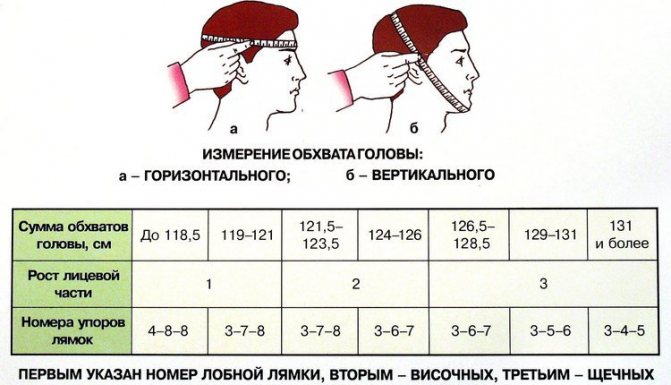
It is easier to navigate using one measurement taken through the cheeks, crown and chin. The correspondence between the height of the helmet and the measurement results looks like this:
- Less than 63 cm – height 0;
- 63.5-65.5 cm – height 1;
- 66-68 cm - height 2;
- 68.5-70.5 – height 3;
- From 71 cm – height 4.
Duration of work in a gas mask
(per one regenerative cartridge):
- during difficult physical activity (running, carrying loads, excavation work) - 40 minutes;
- with average physical activity (gait, servicing mechanisms) - 60 minutes;
. with light physical activity (staying at rest) - 180 min.
To start IP-4 you need:
— install the regenerative cartridge RP-4 on the frame and attach it to the breathing bag;
— attach the helmet-mask to RP-4;
— put the bag with IP-4 over the right shoulder so that it is on the left, and the regenerative cartridge is equal to the waist; — open the lid of the bag, take out the helmet-mask;
- put on a helmet-mask so that there are no folds;
— activate the starting briquette by removing the pin and tightening the screw clockwise to the edge;
— make sure that the color of the thermal indicator that the starting briquette is working changes;
- close the lid of the bag and close it.
Skin protection products designed to protect the human body in conditions of contamination of the area with toxic, radioactive substances and biological agents.
They are also used for degassing, disinfection and decontamination work.
Skin protection products include:
— combined arms protective kit (CPS);
— light protective suit (L-1);
Combined arms protective kit (CPS) designed for reusable protection of human skin, clothing, footwear from toxic substances, biological aerosols, radioactive dust and short-term protection from flammable substances. It consists of a protective raincoat, protective stockings, protective mittens and a carrying case.
The combined arms protective kit can be used in the form of an extension, a raincoat-with-sleeves, or overalls.
The light protective suit L-1 is used when working in conditions of severe contamination with radioactive and toxic substances and bacterial agents. It is made of rubberized fabric and consists of: - pants with boots;
- shirts with a hood;
- bags for storing the suit.
When removing skin protection after being in a contaminated area, special care should be taken not to touch the outer part of the protective clothing with uninfected parts of the body.
Before removing protective clothing contaminated with OR (SDOR), it is necessary to degas the front part of the overalls, especially the sides (chest valve) and mittens with IPP-8 liquid. Those areas of clothing and skin that were contaminated by removing protective clothing are also subject to degassing.
After working in areas contaminated with radioactive substances, the front part of the gas mask, pants with boots, shirt and rubber mittens must be doused with water, wiped with a moistened rag (grass), and the gas mask bag should be shaken out of dust while standing behind the wind.
Contaminated (infected) rags, tampons, etc. are collected in a separate place and thoroughly decontaminated.
Didn't find what you were looking for? Use the search:
Best sayings:
What kind of mathematicians are you if you can’t password protect properly.
8619 –
|
7453 – or read all. 134.249.83.1 © studopedia.ru Not the author of the materials posted. But it provides the opportunity to use it for free. Is there a copyright violation? Write to us | Feedback.
Disable adBlock! and refresh the page (F5)
very necessary
